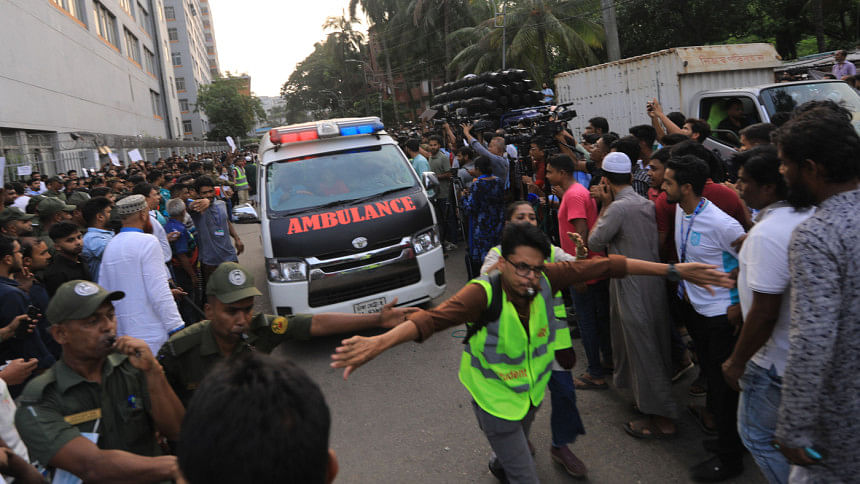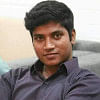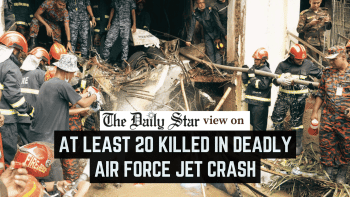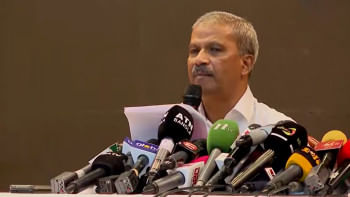Side by side in bandages, siblings fight to survive

Siblings Aryan Ashraf Nafi and Tania Ashraf Nazia lie side by side at the intensive care unit (ICU) of the National Institute of Burn and Plastic Surgery, their small bodies covered in bandages.
Nafi, a class 2 student, suffered 95 percent burns, while his sister Nazia, in class 6, had burns covering 90 percent of her body. Both are students at Milestone School and College -- and they are now fighting for their lives in hospital beds.
Their mother, Tahmina, stood frozen beside them, unable to process the trauma. Their father, a retired army officer, struggled to stay composed.
Though now reunited in the hospital, the siblings had been separated in the chaos that followed the crash of a training jet onto their school compound.
At first, only Nafi was found.
The family searched frantically for Nazia for nearly an hour.
Eventually, it was their aunt, Akhi, who discovered her -- but the relief was instantly crushed by a doctor's grim update: "Her body is 90 percent burned. She's in a very critical state."
Two other children from the same family were also injured in the blast.
Their aunt, Tania -- Tahmina's sister -- was weeping nearby.
Her son, Imam Hossain Junaid, also a class four students at Milestone School and College, was also hurt in the jet crash. Luckily, Tania's daughter is safe and went home after taking primary treatment from the hospital.
Tania's husband serves in the navy.
Of the four children from this extended family, only one is currently out of danger. The other three remain in critical condition. As relatives sat huddled in the hospital corridors in silent prayers, others sobbed openly as the full scale of the tragedy began to unfold.
By 2:30pm, the corridors of the burn institute were already overwhelmed. Stretchers raced through the emergency gate, doctors shouted instructions, and barefoot relatives ran from ward to ward in panic.
In one corner of the hospital, Akhlima Parvin stood crying in the hallway.
Her son, Tawfiq Hossain, a class five student, had just been admitted.
"He had breakfast with me in the morning. I cooked his favourite meal. He was supposed to come back and eat lunch," she said.
Parvin added, "When I heard the blast, I rushed toward the school. I found him injured. He wrapped his arms around me and begged me to save him."
Tawfiq is now undergoing treatment at HDU ward of the institute.
Zahid Hasan, who works as a family driver, had dropped off little Afif at school around 8:00am. As usual, he waited nearby to take the boy home after classes.
"I saw the explosion near Afif's classroom," he said, choking back tears.
"He is now admitted to the burn unit. Please pray for him."
DOCTORS STRUGGLE
Inside the seventh floor of the burn unit, Dr Zakia Sultana Mitali was working in the thick of the emergency when she paused briefly to speak to this correspondent.
"Many of the burn victims are children. Several have inhalation injuries -- their airways are burned. We're doing everything we can," she said.
"But we are under extreme pressure."
Another doctor, requesting anonymity, said, "The number of children is overwhelming. We are struggling to treat them all."
Associate Professor Dr Sayem Al Mansur, who led a four-member medical team in one of the critical wards, added, "One patient in our unit has 100 percent burns. Four others have 90 percent. Five have burns exceeding 80 percent, and several others are over 70 percent."
CROWDS HAMPER EMERGENCY RESPONSE
Outside the emergency gate, a different kind of chaos was unfolding.
While some youth volunteers distributed emergency blood donation forms and tried to maintain order, crowds of political activists, spectators, and onlookers had gathered, blocking entrances and slowing down the response.
Law enforcement from the army, police, Rapid Action Battalion, and Ansar struggled to control the swelling crowd. Ambulances were delayed. Patients waited.
"Some injured children were delayed from being taken inside because people were crowding the entrance," said a hospital staffer.
Despite the crowd, moments of humanity emerged. Young volunteers formed human chains to keep pathways clear for patients and doctors.


 For all latest news, follow The Daily Star's Google News channel.
For all latest news, follow The Daily Star's Google News channel. 










Comments